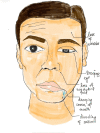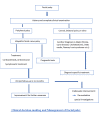Bell's Palsy: A Review
- PMID: 36397921
- PMCID: PMC9648613
- DOI: 10.7759/cureus.30186
Bell's Palsy: A Review
Abstract
Bell's palsy, also known as "acute facial palsy of unknown cause", is a common cranial neuropathy leading to facial muscle paresis or complete paralysis characteristically on one side, occurring suddenly and may progress over 48 hours. It results from facial nerve dysfunction due to trauma or inflammation of the 7th cranial nerve or facial nerve or its branches along its course, primarily in the bony canal. Both sexes are equally affected, and though no age is immune, its incidence rises with increasing age. The risk is high in diabetics, hypertensives, women who are pregnant, obese, and people with upper respiratory tract infections. It is considered chiefly idiopathic and is diagnosed by the exclusion of other causes. Bell's palsy can cause physical and psychological complications and negatively impact patients and their relatives. Thus, early diagnosis and quick cause determination are prime roles in proper treatment. However, the exact etiology of Bell's palsy is unknown, affecting its treatment. Still, determining probable causative and risk factors is critical for employing a targeted treatment approach and requires a comprehensive examination and a complete history. Although the majority of patients recover spontaneously in less than three weeks even if they are not treated. But there is always a risk of residual paresis after treatment or recovery, which may require medical help. This review aims to furnish the most thorough understanding of Bell's palsy, focusing on anatomy, etiology, clinical features, diagnosis, clinical consequences,and preferred therapy approaches.
Keywords: acyclovir; bell's palsy; corticosteroids; electromyography; facial nerve; lower motor neuron palsy; nerve excitability test.
Copyright © 2022, Singh et al.
Conflict of interest statement
The authors have declared that no competing interests exist.
Figures
References
-
- Bell's palsy: a manifestation of prediabetes? Bosco D, Plastino M, Bosco F, et al. Acta Neurol Scand. 2011;123:68–72. - PubMed
-
- Increased risk of Bell palsy in patients with migraine: a nationwide cohort study. Peng KP, Chen YT, Fuh JL, Tang CH, Wang SJ. Neurology. 2015;84:116–124. - PubMed
-
- Radiation exposure and Bell’s palsy: a hypothetical association. Khateri M, Cheraghi S, Ghadimi A, Abdollahi H. https://www.ncbi.nlm.nih.gov/pmc/articles/PMC6169125/#:~:text=Radiation%... J Biomed Phys Eng. 2018;8:337–340. - PMC - PubMed
Publication types
LinkOut - more resources
Full Text Sources
Medical


